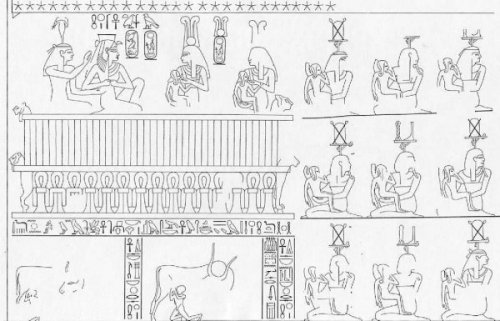| Maat-ka-Ra Hatshepsut |
|
Legend of the Divine Descent - Scene 12 |
update: 27.08.2006 |

| This article about the Habs is based on illustration of scene No. 12 in the temple of Luxor (drawing by Brunner, 1986) and the investigations of Brunner (loc. cited). |
| Description:
The scene is divided into 2 parts, on the left side stands a lion bed with the queen sitting on it (2nd figure from left). The child (in this temple it is Amenhotep III, see 2nd and 3rd cartouche from left which show his throne name "Neb-maat-Ra") is depicted together with its Ka, both are nursed. Since the first cartouche showing "Neb-Maat-Ra" is crowned by a Horus falcon and the 2nd by a double-feather, it is assumed that - from the connection of Horus with the Ka of the king - that the first figure depicts most likely the royal Ka. On the right side of the scene 9 geniuses (in Deir el-Bahari there are 12 of them) are waiting for the child. According to Brunner, 1986, the individual registers of this scene belong together since no vertical dividing lines are present and, beyond that, both the sky (note the stars above) and the text lines above the two cows enclose the picture. On the bed, whose covering is indicated by the vertical lines below the seated figures, 4 women are sitting turned in pairs to each other. From left to the right: - the goddess Selkis (Selket; with the scorpion on her head) who holds her arms protective around the queen, - the queen, who carries here a headdress with vulture-hood, clenching the fists in front of her chest; in front of her head her name in a cartouche, - two nearly identical drawn women (nurses) both decorated with a high double-feather and a small sun disk. The two nurses are probably the cow-goddess Hesat and Sechat-Hor. The child and its Ka are shown sitting upright, both show the typical haircut (curl) of children and touch that arm of the nurse with which she leads her breast to the mouth of the child. The area between the feet of the lion bed is filled with Tjt-knots (Gardiner character V39). The two cows - which are - due to the interpretation of the inscriptions - identified with the "Two Ladies", Wadjit and Nechbet - both turn the head giving a tender look to the child who drinks kneeling and grasping the udder. Among the 9 geniuses certainly the figures 3. and 9 are beardless (the destruction of the 1st figure is too large to make a decision). Every genius carries a child with the typical haircut (curl) of children on the lap. Genius Nos. 1, 4, 6, 7 and 9 each carries a banner with a shield and crossed arrows, figures 3, 5 and 8 carries hb-signs (turned rope and lower leg with foot, Gardiner characters Nos. V28 and D58). |
|
Interpretation
The interpretation of scene is clear: the kings drinks in three important phases of his life (in the early childhood, at his coronation, and at his rebirth after death) the milk of goddesses which gives special power. The right part of the scene with the "maintenance" of the child by 9 geniuses completes the left part. The nutrition of the divine child with milk (of the goddesses) on the left is supplemented by the nutrition with divine meals, here personified by male and female gods of food and meals. In Deir el-Bahari these geniuses are male Kas and female Hemusets. In the temple of Luxor nearly all geniuses are of male sex, six of them are called Hemusets, three as Habs. |
| Habs
The term "hab" occurs only in the Old Kingdom in religious connections as well as in the colloquial language, i.e. always in the change with other words for the rich yield of the "field" or the "river". According to Brunner it is clear that the term "describes" the yield of fishing or catching birds. However, the word disappeared quite early from the colloquial language. Beyond that it is used in the oldest language, i.e. in the pyramid texts, only together with "Ka". In the pyramid texts say that the Great God commands the well-equipped deceased in the "field, the good place" to the "Kas" and assigns them to the "Habu" (plural form). This is represented by the scene in the Luxor temple. However, the Kas were replaced here by Hemusets whereby it is not clear whether erroneously the symbols of the female Hemusets were put on the heads of the male geniuses (Kas) or erroneously the female Hemusets were given beards. Whatsoever, the illustration falls back to sources of the Old Kingdom since later the combination of Kas and Habs is not to testified any longer. summarized according to Brunner, 1986 |